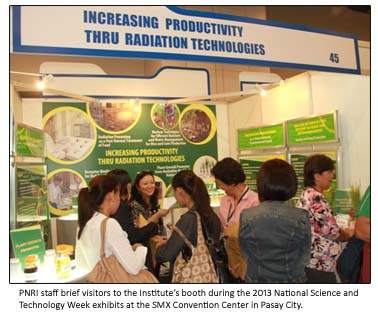 Smart farming techniques for rice and corn production; plant growth promoter from radiation-modified natural polymers such as seaweed; radiation processing of food; nuclear analytical technique for detecting red tide toxin; and gamma column scanning - a non destructive technique that can “see” the flaws inside a steel process vessel in industrial processes: these were the radiation technologies that the Philippine Nuclear Research Institute - Department of Science and Technology showcased during the National Science and Technology Week (NSTW) exhibits at the SMX Convention Center on July 23 - 27, 2013.
Smart farming techniques for rice and corn production; plant growth promoter from radiation-modified natural polymers such as seaweed; radiation processing of food; nuclear analytical technique for detecting red tide toxin; and gamma column scanning - a non destructive technique that can “see” the flaws inside a steel process vessel in industrial processes: these were the radiation technologies that the Philippine Nuclear Research Institute - Department of Science and Technology showcased during the National Science and Technology Week (NSTW) exhibits at the SMX Convention Center on July 23 - 27, 2013.
With the theme “Science, Technology and Innovation: The Road to a Smarter Philippines,” the NSTW celebration, dubbed as Expo Science 2013, was attended by students, teachers, researchers, entrepreneurs, and representatives from the local government units, non-government organizations, private and government sectors.
The Institute’s projects were featured together with almost a hundred other products and technologies from other attached agencies and regional offices of the Department of Science and Technology, as well as several universities and business firms.
The “smart-farming” project of the PNRI’s Agricultural Research Section uses nuclear tracer techniques to determine the efficiency of current fertilizer application and irrigation methods to eventually develop more cost-effective alternatives. The on-going DOST-funded project will identify and refine farming methods which waste away water, fertilizers and nutrients from the soil.
Plant growth promoter/elicitor products developed by science research specialists of PNRI’s Chemistry Research Section from radiation-modified seaweed, crab and shrimp shells increase not only the crop’s yield and nutrient intake but also its resistance to disease and bacteria.
In another project of the Chemistry Research Section, the Receptor Binding Assay technique intends to complement the mouse bioassay method for detectingparalytic shellfish poisoning from red tide and keep the country up to date with the requirements of the CODEX Alimentarius, the international standard for food and consumer health.
Food Irradiation is the focus of the project by the Biomedical Research section, which aims to reduce post-harvest losses by preventing microbial growth and insect infestation as well as to enhance food safety and quality.
The Isotope Techniques Section promotes the application of gamma-ray column scanning for local industries, which will give operators of large-scale plants a real-time image of the insides of columns and process vessels to detect possible damage or malfunction without shutting down the operation.












































